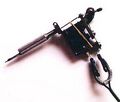File:TattooMachine.jpg and Iceman: Difference between pages
(== Summary == Importing file) Tag: Server-side upload |
(Page conversion via llm-mediawiki-rev -jwm) |
||
| Line 1: | Line 1: | ||
== | '''The Iceman''', named Ötzi after the Ötzal region where he was found, is possibly the most famous mummified corpse in the world. Stumbled upon on September 19, [[1991|1991]] by two climbers high in the Alps, they originally thought they had found the remains of an unfortunate mountaineer. The authorities to whom they reported the find also believed him to be modern, and this led to a level of carelessness in recovering the corpse that would never have been displayed otherwise. A jackhammer, ice-picks, even what turned out to be the Iceman's ancient bow were used to pry him from the glacier before he was forced into a coffin, which resulted in yet more damage. | ||
When the Iceman's age was finally ascertained, it made him the oldest frozen mummy ever found, dating from approximately [[3300 BC|3300 BC]]. | |||
Inspection revealed several markings on the Iceman's skin. Arranged in 15 discrete groups at various locations on his body, they are simple geometric shapes such as lines and crosses. The back of his left knee is [[Tattoo|tattooed]] with some small crosses, and he has short lines on his ankle, two long lines across the front of his wrist, and five groups of lines down the lumbar region of his spine. The markings would not have indicated status, as nearly all of them could be covered by clothing. Their accepted purpose is that they were used in a therapeutic capacity. Almost all of the tattoos correspond to acupuncture points. X-rays showed that the Iceman suffered from rheumatism in the particular joints which were tattooed over, and the tattoos would have been part of his treatment. | |||
While the markings on the Iceman are generally referred to as tattoos, they are more specifically a form of [[Ink rubbing|ink rubbing]]. A healer or shaman would have made incisions over the afflicted areas and placed medicinal herbs into the wounds. The herbs were then burnt, fulfilling a double function in that the charred residue coloured the skin and the heat helped to cauterize the wound. | |||
== See Also == | |||
* [[Egyptian Mummies|Egyptian Mummies]] | |||
* [[Greenland Mummies|Greenland Mummies]] | |||
* [[Pazyryk Mummies|Pazyryk Mummies]] | |||
* [[Scythian Chieftain|Scythian Chieftain]] | |||
Latest revision as of 05:32, 17 September 2023
The Iceman, named Ötzi after the Ötzal region where he was found, is possibly the most famous mummified corpse in the world. Stumbled upon on September 19, 1991 by two climbers high in the Alps, they originally thought they had found the remains of an unfortunate mountaineer. The authorities to whom they reported the find also believed him to be modern, and this led to a level of carelessness in recovering the corpse that would never have been displayed otherwise. A jackhammer, ice-picks, even what turned out to be the Iceman's ancient bow were used to pry him from the glacier before he was forced into a coffin, which resulted in yet more damage.
When the Iceman's age was finally ascertained, it made him the oldest frozen mummy ever found, dating from approximately 3300 BC.
Inspection revealed several markings on the Iceman's skin. Arranged in 15 discrete groups at various locations on his body, they are simple geometric shapes such as lines and crosses. The back of his left knee is tattooed with some small crosses, and he has short lines on his ankle, two long lines across the front of his wrist, and five groups of lines down the lumbar region of his spine. The markings would not have indicated status, as nearly all of them could be covered by clothing. Their accepted purpose is that they were used in a therapeutic capacity. Almost all of the tattoos correspond to acupuncture points. X-rays showed that the Iceman suffered from rheumatism in the particular joints which were tattooed over, and the tattoos would have been part of his treatment.
While the markings on the Iceman are generally referred to as tattoos, they are more specifically a form of ink rubbing. A healer or shaman would have made incisions over the afflicted areas and placed medicinal herbs into the wounds. The herbs were then burnt, fulfilling a double function in that the charred residue coloured the skin and the heat helped to cauterize the wound.
See Also
File history
Click on a date/time to view the file as it appeared at that time.
| Date/Time | Thumbnail | Dimensions | User | Comment | |
|---|---|---|---|---|---|
| current | 03:48, 16 May 2023 |  | 286 × 244 (16 KB) | Maintenance script (talk | contribs) | == Summary == Importing file |
You cannot overwrite this file.
File usage
The following 2 pages use this file: